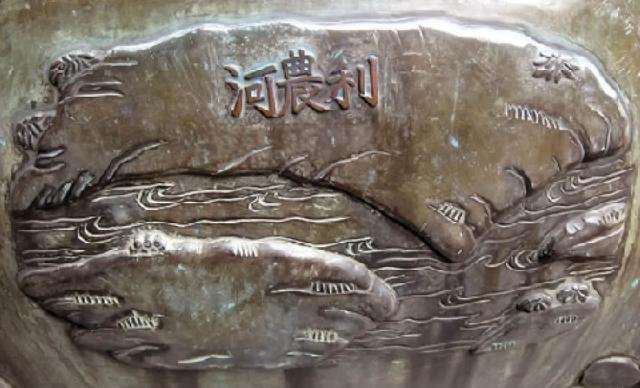
An image of Loi Nong River was engraved on Chuong Urn
According to the book named "Kham Dinh Dai Nam hoi dien su le" (Royal rules and regulations), when it comes to methods of water management, Emperor Minh Mang decreed: "... along the two sides of rivers and sewer and drainage systems, a majority of people are growing their crops and gradually covering these rivers and systems, leading to blocked main river flows or scattered flows of water. To my people, my subjects, I am keenly calling for your suggestions of water management, making rapid currents of the river flow downstream, and developing stable irrigation systems.” This, thereby, shows that Emperor Minh Mang like other Emperors of the Nguyen Dynasty was mainly concerned with improving irrigation efficiency and aware of the importance and significance of rivers in socio-economic development…
Today, many rivers and canals such as Loi Nong River, Nhu Y River, Pho Loi River , Ho Thanh River ... constructed during the reign of Nguyen Dynasty still play an active role in the society. Of those, Loi Nong River was one of the first to be constructed. About 20 km long, this river is a tributary of Huong River. Originating from Da Vien Islet and bending around Hue Railway Station Bridge, the river runs through the southern area of Hue city, wards, communes of Huong Thuy, then flows into Ha Trung Lagoon. This river, at first named An Cuu River, was built in the 13th year of Emperor Gia Long’s reign (1814) with the purpose of “irrigating the fields", as well as preventing waterlogging during rainy seasons, and saltwater intrusion caused by tidal influence.
Legend has it that when the upper basin of An Cuu River was dredged, the habitat of a legendary creature called “giao long” (most believed to look like a crocodile) was disturbed. So, when the weather was hot, this creature often wriggled on the river bed, causing murky water. Therefore,a popular proverb says that "Nui Ngu Binh truoc tron sau meo/ Song An Cuu nang duc mua trong" (which, in general, means the two sides of Ngu Binh Mountain is uneven/ Water of An Cuu River is clear during raining season but murky during sunny days). By the 2ndyear of the Emperor Minh Mang’s reign (1821), the river’s name was changed into Loi Nong River, which means a river that benefits farmers. "Loi Nong River" stele was, then, built and located at the upper and lower basin of the river to commemorate its importance. The river also has some other common names, such as An Cuu, Phu Cam or Thanh Thuy, Dai Giang ... based on where it runs through. In the 16th year of Emperor Minh Mang’s reign (1835), when the Nine Dynasty Urns were moulded, the Emperor had an image of Loi Nong River engraved on Chuong Urn displayedin the Citadel.
The “Loi Nong River” stone stele is now displayed at Thua Thien Hue Historical Museum. It is 70cm high, 13cm thick, 50cm wide in total with a center of 32cm wide. The three words "Loi Nong Ha" meaning Loi Nong River is inscribed on the stele center. This stele was originallycarved and placed on a river bank near Loi Nong river source. This location is right at their headwaters where a tributary of Huong river (at Da Vien Islet section) meanders through Truong Danriver wharf (Hue Train Station bridge at present). Recently, to prevent erosion on both river banks nearthe bridge area,the river bed has been dredged and many types of cannon ammunition of different sizes were discovered. It is possible that this river wharfused to be a place where boats were docked and various guns and cannons were loaded.
A few hundred meters from “Loi Nong river” stele is Nam Giao Bridge, Ben Ngu, where the Emperor’s dragon boat was docked for him to organize Nam Giao sacrifices. Along Loi Nong River banks located many palaces, mansions, and temples, giving Loi Nong Rivera more splendid and romantic view. Around the river lower basin was built Than Phu royal step-over place wherethe Emperor often stopped to rest after sailingand hunting along Loi Nong River.
This precious “Loi Nong River” steleof considerable antiquity gives usan insight into the history of the river formation, its process of existence, and name meaning. It also demonstratesthe Nguyen Emperors’ attempt to develop agriculture and agricultural extension policies. Of those, water management played avital role, which eventually becomes an effective strategy bringing long-term benefits to the people.
Story, photos: NGOC KIEM